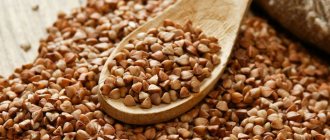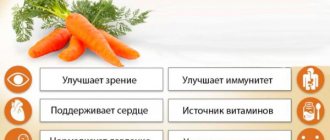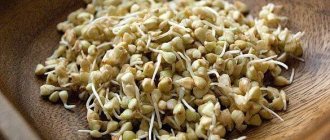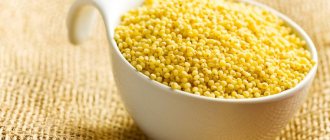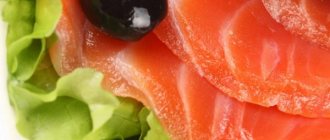Buckwheat was brought to us from Greece, which is why it got its name – buckwheat. Buckwheat is produced from the cereal crop - buckwheat, by cleaning the grain from the hard shell. Buckwheat stores well, does not go rancid, and is widely used for preparing various dishes.
After cleaning, the grain can be steamed, roasted or crushed. But vitamins are best preserved in unfried whole grains - buckwheat.
Despite its high calorie content, buckwheat is a dietary product due to its balanced combination of nutrients and fiber.
Table: calorie content of dry buckwheat, 100 grams of product contains:
| How much fat? | 2.6 g |
| How many carbohydrates? | 68 g |
| How many proteins? | 12.6 g |
| Total calories | 345 kcal |
Carbohydrates in cereals take longer to digest, which is why they are called “slow”; they create a feeling of fullness for a long time, which promotes weight loss. Many dishes are prepared from buckwheat: with milk, with mushrooms, with meat, with stew, with onions and vegetables - it goes well with a variety of products.
Chemical composition of buckwheat per 100 grams
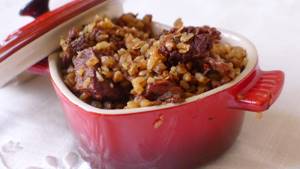
100 g of buckwheat contains:
- vitamin B1 - 28.7% of the norm;
- B2 - 11.1%;
- B6 - 20%;
- N - 20%;
- RR - 36%;
- potassium - 15.2%;
- silicon - 270%;
- magnesium - 50%;
- phosphorus - 37.3%;
- iron - 37.2%;
- cobalt -31%;
- manganese - 78%;
- copper - 64%;
- molybdenum - 49.1%;
- zinc - 17.1%.
Content of vitamins and minerals per 100 g of product:
- A - 2 mcg;
- beta-carotene - 0.01 mg;
- B1, thiamine - 0.43 mg;
- B2, riboflavin - 0.2 mg;
- B3, niacin - 4.2 mg;
- B4, choline - 54.2 mg;
- B5, pantothenic acid - 0.44 mg;
- B6, pyridoxine - 0.4 mg;
- B9, folate - 32 mcg;
- E, alpha-tocopherol - 0.8 mg;
- H, biotin - 10 mcg;
- K, phylloquinone - 7 mcg;
- RR - 7.2 mg;
- aluminum - 33.3 μg;
- boron - 350 mcg;
- vanadium - 170 mcg;
- iron - 6.7 mg;
- iodine - 3.3 mcg;
- cobalt - 3.1 mcg;
- lithium - 4.2 mcg;
- manganese - 1.56 mg;
- copper - 640 mcg;
- molybdenum - 34.4 mcg;
- nickel - 10.1 μg;
- rubidium - 52.5 mcg;
- selenium - 5.7 mcg;
- strontium - 304 mcg;
- titanium - 33 mcg;
- fluorine - 23 mcg;
- chromium - 4 mcg;
- zinc - 2.05 mg;
- zirconium - 35 mcg.
Composition of buckwheat
Most often, buckwheat kernels are used for food - unsteamed and without husks, whole buckwheat grains of a rich brown color. This is the richest product in biochemical composition. It contains:
- starch;
- saturated and unsaturated fatty acids;
- mono- and disaccharides;
- vitamins: groups B, E, A, PP;
- micro- and macroelements: iron, phosphorus, magnesium, potassium, calcium, sodium, sulfur, silicon, iodine, zinc;
- organic acids: oxalic, citric, malic;
- arginine, lysine;
- routine;
- choline;
- folic and nicotinic acid;
- cellulose.
Calorie content, dietary fat and glycemic index
Buckwheat has a low calorie content - 308 kcal per 100 g of dry product. When cooked it is even less - 83.7 kcal. After cooking, the ratio of proteins, fats and carbohydrates changes.
| Nutrient | Dry buckwheat | Boiled buckwheat |
| Squirrels | 12.6 g | 3.6 g |
| Fats | 3.3 g | 0.9 g |
| Carbohydrates | 57.1 g | 16.2 g |
| Alimentary fiber | 11.3 g | 3.2 g |
| Water | 14 g | 74,7 |
| Ash | 1.7 g | 1.259 g |
The glycemic index is 55 units out of 100. This means that the blood sugar level after eating buckwheat rises gradually, so nutrients are fully absorbed and fat is not deposited.

The nutritional value of each dish is different. Buckwheat cooked with different types of meat, as well as in different ways, has different indicators.
Buckwheat porridge with beef stew is rich in vitamin A (22.4%) and beta-carotene (24.2%).
Per 100 g:
- calories - 138.5 kcal;
- proteins - 7.4 g;
- fat - 5.6 g;
- carbohydrates - 15.8 g;
- organic acids - 0.1 g;
- dietary fiber - 0.6 g;
- water - 47.3 g;
- ash - 0.213 g.
The calorie content of buckwheat with minced meat is 141.8 kcal.
Compound:
- proteins - 7.2 g;
- fat - 7.2 g;
- carbohydrates - 12.4 g;
- dietary fiber - 0 g;
- water - 0 g.
100 g of buckwheat with blood sausage contains 274 kcal. This is twice as high as in porridge with stewed meat or minced meat.
Compound:
- proteins - 9 g;
- fats - 19.5 g;
- carbohydrates - 14.5 g;
- dietary fiber - 0 g;
- water - 0 g.
The beneficial properties of buckwheat with turkey include a high content of vitamin A (21.2%), beta-carotene (22.9%), silicon (42.9%), manganese (13.6%), copper (11.1 %).
Compound:
- calories - 100.3 kcal;
- proteins - 9.4 g;
- fats - 2.1 g;
- carbohydrates - 10.2 g;
- dietary fiber - 2.3 g;
- water - 46 g.
The energy value of buckwheat with chicken is 164.6 kcal.
Compound:
- proteins - 10.4 g;
- fats - 6.2 g;
- carbohydrates - 16.9 g;
- dietary fiber - 1.9 g;
- water - 0 g.
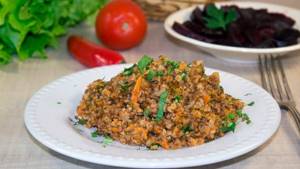
The number of calories in 100 g of buckwheat with pork is 141.5 kcal.
Compound:
- proteins - 9.2 g;
- fats - 4.8 g;
- carbohydrates - 15.4 g;
- dietary fiber - 3.2 g;
- water - 66 g.
The energy value is 160 kcal.
Compound:
- proteins - 17.2 g;
- fats - 6.9 g;
- carbohydrates - 7.3 g;
- dietary fiber - 1.4 g;
- water - 67 g.
Contents per 100 g serving:
- calories - 130 kcal;
- proteins - 2.1 g;
- fat - 6.5 g;
- carbohydrates - 13.3 g.
How many calories are in boiled buckwheat, with water and milk - Athlete's Body
Buckwheat is one of the best dietary foods. Many people classify buckwheat as a grain, but this is a mistake. It is known that buckwheat was brought from Greece.
The benefits of buckwheat are obvious, because it contains a large amount of polyunsaturated fatty acids, which reduce cholesterol levels and also affect metabolism, due to which you can achieve faster weight loss.
This occurs despite the fact that this product is high in calories.
Since buckwheat contains a large amount of flavonoids, this cereal can stop the growth of cancer and there will be no risk of thrombosis.
Buckwheat is also good for diabetics, as it regulates the amount of sugar in the blood. And folic acid, which is contained in this cereal, is very useful for pregnant women.
How many calories are in boiled buckwheat?
Scientists have calculated that 100 grams of dry buckwheat contains approximately 370 calories. Boiled buckwheat porridge contains about 150 calories, taking into account the amount of water that the cereal absorbs. It contains 5.9 g. proteins, 1.6 g. fat and 29 gr. carbohydrates.
How many calories are in buckwheat with water?
If you cook buckwheat in water (you get a liquid porridge), then 100 grams of such a dish will contain approximately 90 calories.
Buckwheat contains many minerals and vitamins. If you add a piece of butter to buckwheat cooked in water, the number of calories will increase significantly. Therefore, porridge with butter is not suitable for a diet.
If you add salt and oil to buckwheat with water, its calorie content will increase to almost 500 calories per 100 grams! Heat treatment does not affect the number of calories in porridge.
The buckwheat diet is beneficial for the body, as buckwheat contains many amino acids, iron, vitamins PP, and B, as well as phosphorus, calcium, iodine, and oxalic acid.
At the same time, buckwheat has an excellent taste. Therefore, it can be used for both diets and medicinal purposes. The folic acid in buckwheat strengthens blood vessels and the heart.
How many calories are in buckwheat with milk?
To prepare buckwheat with milk, it is better to take skim milk made from whole product.
You can calculate the calorie content of buckwheat porridge with milk approximately this way: 100 grams of porridge + 50 grams of milk contains 200 calories.
This dish is universal and can be consumed at any time during the day. Porridge with milk improves metabolism in the body, and the body also receives proteins from it very easily.
In addition, it contains a large amount of fiber, which removes toxins from the body.
Another feature of consuming buckwheat is considered to increase immunity. It also helps the liver function and improves the functioning of the gastrointestinal tract.
To prepare buckwheat with milk, use the following proportion - 100 grams of ready-made porridge should be poured with half a glass of milk.
| Pectoral muscles |
| Legs |
| Shoulders |
| Press |
| Back |
| Hands |
Source:
Calorie content of buckwheat with milk
It is no coincidence that buckwheat received such a name. It was brought to Russia from Greece by monks or merchants who traded with the Byzantine Empire.
Widespread during the time of Ivan the Terrible, buckwheat remains one of the most popular and beloved cereals to this day.
Rich in vitamins, nutrients, and fiber, it is recommended for use by nutritionists during weight loss and for various diseases.
Many people are concerned about the calorie content of the product. This is especially important for those who are watching their weight. Let's find out how nutritious buckwheat porridge is when combined with milk.
As already mentioned, buckwheat is a dietary product. 100 grams of dry buckwheat contains 345 calories.
Despite the considerable calorie content of the product, its balanced content of nutrients and fiber allows it to be consumed even with the strictest diets.
In addition, it contains so-called slow carbohydrates (it is thanks to them that the cereal is so filling and gives a boost of energy for the whole day).
Buckwheat contains a high amount of polyunsaturated acids. They have a positive effect on cholesterol levels, reducing it, and regulate metabolism, which is especially important for those who want to lose excess weight.
Buckwheat also contains a large amount of amino acids (substances that are the basis of protein molecules). That is why buckwheat is recommended to be included in the diet during diets and during active sports.
Lysine is another important component that performs many functions. This substance reduces the risk of infectious diseases. It must be present in the daily diet of every person. Fiber, which has already been mentioned, promotes normal digestion and prevents intestinal diseases.
Buckwheat porridge is cooked for breakfast, lunch and dinner. It is prepared with vegetables, meat, nuts, milk and kefir. The combination of the product with milk is especially popular. A lot has already been said about the benefits of buckwheat.
And it’s no secret what importance milk has for the human body.
It contains calcium necessary for bones and teeth, it promotes normal metabolism, and includes many vitamins.
Buckwheat porridge with milk is not only a tasty and healthy dish, but also filling. However, the calorie content of boiled buckwheat with milk per 100 grams is only 200 kcal.
This dish is allowed to be eaten by everyone except people with lactose intolerance. It will become both a worthy element of a regular diet and an excellent part of the menu during a diet. Due to its properties, buckwheat will saturate the body, giving a feeling of fullness for many hours.
If you are not following a strict diet, you can add a piece of butter and a drop of honey to the milk porridge. the calories in such a dish will increase by almost a hundred, but its taste will become more intense.
Thus, the calorie content, protein, fat and carbohydrate content (otherwise - BZHU or KBZHU) in 100 grams of buckwheat with milk is:
- calories - from 135 to 300 (depending on the cooking method);
- proteins – 4 grams;
- fats – 3.75 grams;
- carbohydrates – 12.6 grams.
Compared to other cereals, buckwheat contains a minimal amount of carbohydrates. They are absorbed slowly, due to which you don’t feel like eating for a long time after eating buckwheat.
Buckwheat with milk contains iodine in sufficient quantities, which is known to prevent the risk of tumors.
This dish is also recommended when the level of hemoglobin in the blood decreases and after operations.
Having found out how high-calorie this dish is, it’s worth figuring out how to prepare it in such a way as to get the maximum benefit and taste.
One of the most popular diets is the buckwheat and milk diet. Thanks to its many nutrients, this product is simply ideal for a balanced diet.
The duration of such a diet is no more than two weeks, and the result will be noticeable within a few days.
The daily diet includes only buckwheat porridge, which is recommended to be cooked with milk, low-fat kefir or water.
Thanks to the high calorie content of buckwheat, the feeling of hunger will not torment you throughout the day, and the slow carbohydrates included in its composition will allow you to be satisfied with small portions without feeling tired or lack of strength.
This diet is very effective, but concomitant health problems cannot be ruled out after its completion. It is not recommended for people with poor health, pregnant women and teenagers.
If you feel unwell, you should dilute your diet with vegetables, sugar-free fruits, dried fruits, nuts or dark chocolate.
It is much safer to choose any less strict diet and include buckwheat porridge in it.
It is not difficult to prepare a dish so that it turns out to be low-calorie. You will need:
- buckwheat grain;
- water;
- milk with low fat content.
As you know, during heat treatment many useful substances are lost, which should absolutely not be allowed when losing weight. To preserve all the beneficial properties of buckwheat, it is recommended not to cook it, but to steam it.
The glass of buckwheat must be thoroughly rinsed and allowed to sit for some time. The cooking principle differs in that buckwheat is poured with hot water, but is not boiled, but remains under a closed lid in a warm place for several hours. This will make the finished dish healthier than what is obtained with regular cooking. After this, the porridge is poured with low-fat milk. The dish is ready to eat.
You are allowed to eat several medium portions per day.
For those who do not follow a strict diet, there is another recipe. There will be more calories in such a dish, but it will turn out much tastier. In addition, this option can be a good family dinner or breakfast; it is recommended for children, as it is tasty and rich in vitamins.
You will need:
- buckwheat grain;
- water;
- milk;
- sugar and salt;
- butter.
Buckwheat should also be washed and allowed to settle, after which it should be poured into a saucepan and filled with water in a ratio of 1: 2 (i.e., two glasses of water are required for one glass of cereal). Stirring thoroughly, bring the porridge to a boil, add a little salt for taste, cover with a lid and leave on low heat for twenty to twenty-five minutes until cooked.
After this, you need to pour milk into the pan, add a few tablespoons of sugar and a piece of butter. The dish should be brought to a boil, then removed from the heat and allowed to brew a little. No less tasty than oatmeal, but a healthier breakfast for the whole family is ready.
You will learn more about how to cook buckwheat with milk in the following video.
Source:
How many calories are in buckwheat boiled in water and more?
Buckwheat is a nutritious and low-calorie product with the content of essential vitamins, macro- and microelements, and complete proteins necessary for human health.
For those who want to lose weight or include healthy foods in their diet, the question of how many calories are in buckwheat is important.
The calorie content of this cereal will also be of interest to those who lead an active lifestyle, play sports and watch their weight.
The benefits of buckwheat for the body when losing weight
Regular physical activity, a healthy lifestyle and proper nutrition are the main components of the weight loss process.
Useful: Proper nutrition menu for every day for weight loss
The presence of buckwheat in the diet has a beneficial effect on the figure and condition of the body as a whole.
The high content of essential proteins, slow carbohydrates, amino acids, minerals (iron, iodine, phosphorus, copper) and vitamins (vitamins PP, E and group B) help buckwheat dishes become extremely tasty and healthy .
Regarding nutrients, 100 grams of dry buckwheat contains about 16% protein, 3% fat and 1% fiber.
Buckwheat has the following essential properties for overall health:
- Removes heavy metals, toxins and cholesterol from the body.
- Improves metabolism and digestion process.
- Regulates blood sugar levels.
- Reduces the risk of cancer and cardiovascular diseases.
- Promotes the breakdown of fats.
Buckwheat is an excellent dietary product for weight loss, which saturates to the maximum, improves digestion, but at the same time cleanses the entire body.
Buckwheat how many calories in 100 grams
Buckwheat porridge and other dishes made from cereals have a beneficial effect on the condition of the human body and overall well-being due to its high energy value , as well as a balanced composition of mineral components.
How many calories are in 100 grams of raw and boiled buckwheat? The energy value of cereal in a dry state is 330 calories, which is 13% of the daily intake. Since the grains swell during cooking and increase almost 3 times, actively absorbing water, the calorie content of the finished product is significantly reduced .
The nutritional value of boiled buckwheat always depends on the method of its preparation. 100 grams of porridge cooked in drinking water without adding oil and auxiliary ingredients, as a rule, does not exceed 103-110 calories.
This dish contains: 4 g of protein, 21 g of carbohydrates, 1 g of fat per 100 grams of the finished product. Despite these indicators, the prepared porridge contains absolutely no quickly digestible carbohydrates and saturated fats. Thanks to this, buckwheat can be included in the breakfast menu, which will help saturate the body sufficiently until lunch.
How many calories are in boiled buckwheat?
It’s quite easy to make crumbly porridge from whole buckwheat.
May be useful: How to cook fluffy rice in a saucepan
Often, buckwheat is boiled in water, meat broth or milk, followed by the addition of various products (vegetables, butter, meat, nuts, honey, dried fruits).
Nutritionists, having noted how many calories are in buckwheat boiled in water, recommend consuming it often during fasting days or as a dietary dish. The average calorie content of boiled buckwheat is 110 kilocalories per 100 grams.
To improve the taste, you can add salt, sugar and butter to taste . The nutritional value of porridge without oil, as a rule, will be no more than 95-110 kcal.
A serving of buckwheat cooked in water without salt can contain up to 90 kcal, while buckwheat with salt contains about 100-103 kcal. If you add sauce or butter (butter, sunflower) to the porridge, the nutritional value can increase to 140-160 kcal.
The exact value of boiled porridge in water can be calculated by independently taking into account the quantity and type of products added. To do this, you just need to add the amount of energy value of buckwheat and the calorie content of additional components.
Source: https://fsk-belebey.ru/trenirovki/skolko-kalorij-v-varenoj-grechke-na-vode-is-molokom.html
Features of eating buckwheat on a diet
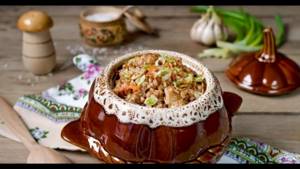
The buckwheat diet is popular because it is effective and can be combined with many foods. Nutritionists consider it more therapeutic, because thanks to it the body is cleansed of waste and toxins.
The initial version of the buckwheat diet consists only of cereals and water. The consumption of buckwheat is not limited; drink at least 1.5 liters of water per day. The effect occurs on the second day - minus 1 kg. For obese people, better results are possible.
But this menu has a big drawback - muscle mass is lost. The skin becomes dull and flabby. Muscles lose elasticity. The body lacks proteins and fats. Therefore, during the buckwheat diet, it is necessary to take multivitamin complexes.
There are 3, 7, and 14-day buckwheat diets in duration. Not every body can withstand such stress without consequences. Therefore, nutritionists have developed diet options with additional ingredients. These include chicken breast, vegetables, turkey meat, cottage cheese, herbs, low-fat kefir and yogurt, and fruits.
Proponents of proper nutrition answer positively, but under certain conditions:
- eat green buckwheat or eggplant;
- the cereal is boiled and steamed;
- combined with poultry, beef, pork;
- the meat is boiled, stewed, fried, steamed, baked in the oven.
How many calories are contained in buckwheat with meat depends on these factors.
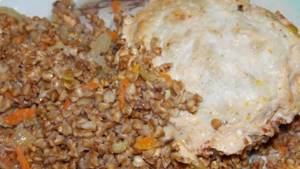
The buckwheat diet with chicken breast has many positive reviews. The body gets rid of excess weight without losing muscle mass. The calorie content of this dish is 100.7 kcal per 100 g.
What is the situation with other types of meat in combination with buckwheat?
| Addition to boiled egg | Calorie content, kcal |
| boiled turkey breast | 100,3 |
| boiled chicken breast | 100,7 |
| steamed minced chicken | 121,8 |
| beef stew | 138,5 |
| boiled pork | 141,5 |
| braised chicken breast | 143,8 |
| beef stew | 160 |
| minced beef stew | 173,6 |
| beef, fried in small pieces | 184,9 |
| minced chicken fried with carrots | 195,7 |
| blood sausage | 274 |
The table shows that the calorie content of dishes directly depends on the method of preparation.
Boiled meat brings great benefits. The calorie content of buckwheat with stewed meat is much lower than a dish with minced meat fried in a frying pan.
When eating these types of meat with green buckwheat, the energy value of the dishes is almost the same. But sprouted green cereals saturate the body with much more vitamins and microelements.
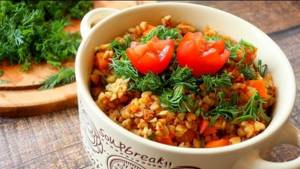
An effective way to lose weight is the buckwheat-chicken diet. How products are processed:
- Cook the cereal in unsalted water - 1 tbsp. cereals for 2 tbsp. water. Duration: 15 minutes.
- Boil skinless and boneless chicken breast in unsalted water until tender.
The duration of the diet is from 3 to 14 days.
Sample menu for one day:
- First breakfast: 100 g of steamed cereal and 200 ml of low-fat kefir. It is better to steam buckwheat overnight.
- Second breakfast: 50 g of boiled buckwheat and unsweetened fruit.
- Lunch: salad of tomatoes, herbs, cucumbers, dressed with olive oil; boiled breast; buckwheat cooked in water; tea without sugar.
- Afternoon snack: fruit.
- Dinner: boiled chicken breast and low-fat yogurt.
The advantage of the buckwheat-chicken diet is that the menu includes a large number of auxiliary products.
The menu is varied with vegetables, cottage cheese, herbs, fruits, and low-fat fermented milk drinks. You are allowed to drink tea or coffee without sugar once a day. Drink at least 1.5 liters of filtered water.
There are many options for losing weight on buckwheat. They are tested and effective. The extra pounds go away quickly, but the body suffers from a lack of vitamins and minerals.
When adding vegetables, the picture does not change, since there is not enough protein. As a result, muscle is burned, not excess fat.
When meat is included in the diet, the body receives the necessary protein. The body does not flabby, the muscles do not sag, they remain elastic. Buckwheat is the main product that supplies carbohydrates. Meat serves as a source of protein for the body.
Beneficial features
Buckwheat can be a complete substitute for meat, which is explained by its nutritional capabilities. Thanks to its rich chemical composition, it is able to saturate the human body with essential vitamins and microelements. It is recommended to include it in your daily diet to avoid many health problems.
Useful properties of buckwheat:
- Stabilizes blood pressure and hematopoiesis.
- Positively affects the musculoskeletal component.
- Activates the central nervous system and enhances brain activity.
- Serves as protection against malignant neoplasms.
- Prevents the development of cardiovascular diseases, strengthens vascular walls.
- Normalizes digestion: improves intestinal motility, relieves constipation.
- Increases immunity.
- Reduces “bad” cholesterol and hemoglobin levels in the blood.
- Cleanses away impurities and toxins.
- Uplifts your mood and energizes you.
- Helps eliminate swelling and inflammation due to arthrosis, arthritis and rheumatism.
Buckwheat dishes are recommended for constant consumption by children, which contributes to the normal development of the growing body. At the same time, mental abilities improve: concentration and memory. People involved in sports need such a nutritional supplement to gain muscle mass. This is due to the saturation of buckwheat with carbohydrates, which during the digestion process release a large supply of energy. Against this background, training is more productive.
For men, systematic consumption of buckwheat dishes will help in case of problems with potency and prevent inflammatory processes in the prostate gland.
Buckwheat is no less useful for women, as it improves appearance: it has a positive effect on the skin, structure of hair and nails. As a result, acne and irritation on the face disappear, and the skin becomes more elastic. Thanks to the cereal, hormonal levels return to normal, which is especially important during the onset of menopause and shortly before.
During pregnancy
During pregnancy, it is recommended to consume buckwheat regularly, as it is a valuable supplier of vital substances for both mother and child. Folic acid in its composition helps the proper development of the baby's central nervous system and prevents premature birth.
The high iron content makes cereal an indispensable remedy for the prevention of anemia. Its other components have a beneficial effect on the heart and blood vessels: they prevent varicose veins, control blood pressure, and protect against the development of atherosclerosis. It is impossible to gain weight on such dishes.
When breastfeeding, a woman should especially monitor her diet so as not to harm the baby. Eating buckwheat allows you to avoid many digestive problems in a newborn: bloating, colic and allergies.
When losing weight
Buckwheat is considered a dietary but nutritious product. Therefore, it is easy to lose weight on it, without the constant hunger inherent in many diets. Buckwheat dishes fill you up well and for a long time, which eliminates unnecessary snacks during the day. Despite the meager diet during such weight loss, the body does not experience much stress. This is due to the balanced and rich chemical composition of the cereal.
Intensive fat burning occurs due to:
- improving bowel function;
- enhancing metabolism;
- removal of excess fluid from the body;
- cleansing of waste and toxins.
It is enough to replace 1-2 meals a day in your usual menu with dietary buckwheat dishes, due to which you can lose up to 2 kg of excess weight in 7 days.
Product calorie analysis
Ratio of proteins, fats and carbohydrates:
- Vitamin B12 plays an important role in the metabolism and transformation of amino acids. Folate and vitamin B12 are interconnected vitamins that are involved in hematopoiesis. A lack of vitamin B12 leads to the development of partial or secondary folate deficiency, as well as anemia, leukopenia, and thrombocytopenia.
- Vitamin PP is involved in redox reactions of energy metabolism. Insufficient vitamin intake is accompanied by disruption of the normal condition of the skin, gastrointestinal tract and nervous system.
- Phosphorus takes part in many physiological processes, including energy metabolism, regulates acid-base balance, is part of phospholipids, nucleotides and nucleic acids, and is necessary for the mineralization of bones and teeth. Deficiency leads to anorexia, anemia, and rickets.
- Iron is part of proteins with various functions, including enzymes. Participates in the transport of electrons and oxygen, ensures the occurrence of redox reactions and activation of peroxidation. Insufficient consumption leads to hypochromic anemia, myoglobin deficiency atony of skeletal muscles, increased fatigue, myocardiopathy, and atrophic gastritis.
- Selenium is an essential element of the antioxidant defense system of the human body, has an immunomodulatory effect, and is involved in the regulation of the action of thyroid hormones. Deficiency leads to Kashin-Beck disease (osteoarthritis with multiple deformities of the joints, spine and limbs), Keshan disease (endemic myocardiopathy), and hereditary thrombasthenia.
- Zinc is part of more than 300 enzymes and is involved in the processes of synthesis and breakdown of carbohydrates, proteins, fats, nucleic acids and in the regulation of the expression of a number of genes. Insufficient consumption leads to anemia, secondary immunodeficiency, liver cirrhosis, sexual dysfunction, and the presence of fetal malformations. Research in recent years has revealed the ability of high doses of zinc to disrupt the absorption of copper and thereby contribute to the development of anemia.
still hide

Benefits and composition of buckwheat
The chemical composition of the kernel is varied. It contains:
- beta-carotene;
- B vitamins (B1, B2, B5, B6, B9);
- vitamin E;
- vitamin PP,
- vitamin N.

Of the minerals necessary for normal functioning of the body, buckwheat contains:
- potassium;
- copper;
- magnesium and manganese;
- iodine;
- iron;
- zinc and selenium;
- fluorine and nickel;
- zinc and chlorine.
In addition to vitamins and minerals, cereals are rich in easily digestible protein of plant origin, which promotes hematopoiesis and increases the level of hemoglobin in the blood. Buckwheat porridge is recommended for use in case of kidney and liver diseases, a tendency to edema, diabetes mellitus, obesity, hypertension, atherosclerosis, etc. Regular consumption of buckwheat dishes increases the body's resistance to infectious diseases and reduces cholesterol levels. Buckwheat is allowed for diseases of the gastrointestinal tract and cardiovascular system.

Calorie content of buckwheat per 100 g
How many calories are in buckwheat depends on the type of grain and the method of heat treatment, as well as additional products used to prepare the dish. Dry buckwheat has a caloric content of 306 kcal per 100 g, so buckwheat is more caloric than rice (340 kcal), and it is also less caloric than corn grits (325 kcal), bulgur (342 kcal), spelt (336 kcal) or quinoa (368 kcal).
The calorie content of food buckwheat is usually lower (about 290 kcal), buckwheat has about 306 kcal, green groats - 308 kcal, and kernels - 313 kcal.
Is it possible to eat buckwheat while losing weight?
Today, one of the most popular ways to quickly lose weight is the buckwheat diet. What is the secret of her success and how accessible is she? Let's figure it out.
To begin with, this type of weight loss, unlike many others, not only does not harm the body, but, on the contrary, is a real first aid for it. After all, buckwheat is a true storehouse of vitamins and microelements that are so necessary for the body to function properly. And then, unlike many other diets, this one is not at all burdensome, since buckwheat has such a bright taste and smell that it can easily be eaten even without salt and spices.
In order to quickly and significantly lose weight in a short period of time, it is best to eat steamed buckwheat rather than boiled buckwheat. To do this, you need to pour boiling water over it in the evening and leave it to swell overnight. In the morning you will receive a complete porridge, which will differ from boiled porridge only in a much larger amount of useful substances.
You can add green onions or dill to the buckwheat - this will make the dish even tastier. For lunch, it can be used as a side dish for boiled veal or chicken breast. But it’s better not to eat buckwheat porridge at night - it simply won’t have time to be digested and instead of promoting weight loss, it will have the opposite effect.
You shouldn’t go overboard with such a diet either - it’s better to stay on it for no more than a week and no more often than once a month. Then you will achieve the maximum positive effect: you will lose excess weight and improve your body health.
Here we can already talk about additional calories, but also about additional health benefits. However, if you don’t snack on your porridge with whipped cream or half a cake, then, of course, you won’t gain weight.
It is best to season buckwheat with oil during the cooking process. If you want the porridge to turn into a real culinary masterpiece, shortly before turning it off, when all the water has already boiled away and been absorbed, add about a third of a stick of butter and cook in it a little more.
And in order to get a healthy, dietary and lean dish, it is quite acceptable to season buckwheat with vegetable oil, which can be added both during cooking and added to the ready-made porridge. Olive and grape oils are especially useful. The first is an inexhaustible source of omega acids and has a choleretic effect, and only one teaspoon of the second replenishes the body’s daily need for vitamin E, which is responsible for the beauty and health of our skin.
Boiled buckwheat is not only a dietary dish for weight loss, but also an excellent side dish. It goes especially well with mushrooms and onions. To prepare this tasty and lean dish, you must first boil the cereal. To do this, you need to sort it out, rinse it and fry it in a dry frying pan - this will give the future porridge a crumbly quality. The cereal must be poured into salted boiling water and cooked until it becomes soft enough and the water boils away. There is no need to stir the porridge during the process. Buckwheat in bags is also good for this dish.
While the cereal is cooking, you can start seasoning. To do this, you need to cut 1-2 onions (this depends on the expected quantity and your taste), and also wash the champignons. If they are large, then it is worth cutting them into 2 or 4 parts. It’s even better to use oyster mushrooms in this recipe - they have a richer mushroom flavor and delicate texture. Fry mushrooms and onions in a frying pan, adding a little vegetable oil. Use salt and spices to taste and desire. When the onions are browned and the mushrooms give out juice (it will become a kind of sauce when mixed with oil), remove the dressing from the stove and add it to the prepared buckwheat porridge, mixing thoroughly. Also choose the proportions to your taste, but anyone will say that the more mushrooms and onions in the porridge, the better.
This section presents the calorie content of buckwheat with beef in various preparations, as well as the content of proteins, fats and carbohydrates. All data is provided per 100 grams of the finished product. To find out the content of BZHUK in a serving (plate), enter the required amount of product into the calculator.
1 standard serving of food (plate) = 250 grams.
How to use
Eating buckwheat for weight loss will not bring the desired result if you combine it with certain foods:
- fat meat;
- sugar;
- smoked meats;
- sauces, mayonnaise;
- oil in large quantities.
It is advisable to eat any buckwheat dishes in the first half of the day. It is not forbidden to eat them in the evening, but no later than 18:00. You cannot eat buckwheat at night, as the product takes 1.5-2 hours to digest, which will not allow the digestive system to fully rest.
For fasting days, it is recommended not to cook the cereal, but to soak it. Then it retains more vitamins and microelements. To do this, you will need 200 ml of boiling water for 1 glass: steam it in a thermos in the evening and leave it overnight. In the morning, drain off the remaining liquid. There is no need to add salt or add anything. Divide the resulting dish into 5-6 servings and eat throughout the day.
If the bland taste of the porridge is unbearable, then you can add a little chopped herbs, kelp (seaweed) or a spoonful of honey.
With daily mental stress, such a poor diet can provoke increased cravings for sweets. Then you should mix porridge with dried fruits for breakfast, and drink a glass of honey water on an empty stomach every morning.
You can’t eat buckwheat alone for a long time, maximum 5–7 days. Otherwise, the body begins to lack minerals and other nutritional components. Therefore, they additionally eat fresh fruits and vegetables, eggs, sea fish, white meat and drink a lot. The result of losing weight in this way depends not only on the amount eaten, but also on optimal physical activity.
Buckwheat diet
The buckwheat diet is indicated not only for weight adjustment, but also in case of certain health problems. Cereals can be eaten in any form: boiled, steamed, soaked in kefir, baked. The menu for the day is varied, but within acceptable limits regarding the food set.
The advantage of such a diet is that buckwheat is allowed to be eaten in unlimited, but reasonable quantities. Because of this, those losing weight do not experience discomfort throughout the entire restrictive period. There is no need to count calories every day. In a week you can lose 7-8 kilograms while maintaining muscle mass.
The essence of the buckwheat diet:
- Eat 4-5 times in small portions. To avoid overeating, it is recommended to replace your usual plates with smaller ones, with a volume of 200–250 g.
- Drink up to 2 liters of water per day.
- Exclude from the diet foods and unhealthy drinks that are not included in the menu: store-bought juices, sweet soda, alcohol.
- Minimize salt intake.
- Stop eating 3 hours before bedtime.
Additional drinks: kefir (1% fat), still mineral water, green tea and herbal infusions. If you have an increased craving for sweets, then drink honey water: 1 tsp per glass. Suitable snacks include: green apples, oranges, grapefruit. You can eat no more than one fruit per day.
For the first 2–3 days, the basic dish is raw buckwheat porridge, then it is allowed to include various dietary recipes from cereals. Usually this regime is followed for a week, but if you are comfortable, it can be longer.
Options for light short-term buckwheat diets:
- Kefir. A fermented milk product is added to the classic version at the rate of 1 liter per day. They wash it down with porridge or put it directly into it.
- With fruits and vegetables . Any fruit except grapes, bananas, dates is mixed or eaten whole. Additionally include fresh or steamed non-starchy vegetables.
- Strengthening . The most varied nutritional option, where in addition to buckwheat it is acceptable to eat something else: cottage cheese for breakfast, veal and vegetable salad for lunch. Portions on this diet are larger, but the number of meals is reduced to 3.
If you eat only buckwheat, without salt and oil, then excess weight will go away very quickly. However, this is an emergency measure that will not bring health benefits.
All buckwheat and beef dishes in a row:
Didn't find the product or dish you were looking for?
Let us know in a comment and we will add it:
Buckwheat was brought to us from Greece, which is why it got its name – buckwheat. Buckwheat is produced from the cereal crop - buckwheat, by cleaning the grain from the hard shell. Buckwheat stores well, does not go rancid, and is widely used for preparing various dishes.
After cleaning, the grain can be steamed, roasted or crushed. But vitamins are best preserved in unfried whole grains - buckwheat.
Despite its high calorie content, buckwheat is a dietary product due to its balanced combination of nutrients and fiber.
Table: calorie content of dry buckwheat, 100 grams of product contains:
| How much fat? | 2.6 g |
| How many carbohydrates? | 68 g |
| How many proteins? | 12.6 g |
| Total calories | 345 kcal |
Boiled buckwheat: calorie content, composition, health benefits
Boiled buckwheat, whose calorie content is the key to successful weight loss, is considered an ideal product for dieting.
Today we will look at how this cereal is useful for the body, what its energy and nutritional value is.
And also how to properly cook and consume porridge to achieve and maintain the desired figure! Stay with us until the end of the article. You will learn things you couldn’t even imagine!
The benefits of buckwheat porridge, the health benefits of buckwheat
This dish has a fairly low energy value. At the same time, buckwheat porridge has an impressive list of minerals, vitamins, and other substances beneficial to health contained in the grains.
Proof of this is at least the fact that it is present in the menu of recovery diets and fasting days for weight correction. However, the dish cannot replace fresh vegetables and fruits.
Buckwheat is rich in carbohydrates necessary for a full, healthy human life. But “fast” carbohydrates can cause a sharp increase in blood sugar levels. Thus, porridge can be included in the menu for diabetes and other diseases. At the same time, “slow” carbohydrates can eliminate the feeling of hunger for a long time, charging the body with energy for the whole day!
By eating buckwheat porridge for weight loss without sauces, broth, butter, sugar, you can quickly, effectively (and most importantly, safely) lose excess weight! In addition, you will be able to remove excess fluid from the body and improve muscle tone. And also restore beauty to your skin and hair.
At the same time, buckwheat porridge is useful for the following ailments and conditions:
- pregnancy
- lactation
- elderly people after major surgery
- for obesity
- for diabetes
- for the prevention of renal and hepatic hemorrhages, vitamin deficiency, heart disease
- for the prevention of cancer
- against edema
Buckwheat: chemical composition
Having considered the calorie content of boiled buckwheat per 100 grams, it is worth talking about what makes this dish so healthy. A unique list of substances necessary for our body contains vitamins B2 and B1.
Just one serving of this porridge provides about 40% of the daily requirement of these substances! In addition, cereals are rich in vitamin PP, a deficiency of which leads to hair loss and excess weight gain.
Also, a 100-gram plate of crumbly, flavorful cereal contains half the daily requirement of iron! And, as we know, this element is necessary for proper metabolism and immunity.
The grains contain calcium, which is necessary for the strength of tooth enamel, bone tissue, and hair.
At the same time, this cereal contains absolutely no vitamins C and A. That is why world nutritionists recommend that while following the buckwheat diet, you should include vegetables and fruits that contain these substances in your menu.
Ideal accompanying products for this dish are:
- kiwi;
- oranges;
- carrot;
- grapefruits;
- fresh herbs (cilantro, dill or parsley).
The main advantage of cereals is their high protein content. Therefore, if you like active sports, then a buckwheat diet will help quickly restore muscle tissue.
In addition, this cereal is considered one of the best alternatives to animal protein, but it does not contain harmful saturated fats.
For this reason, it is better to supplement it with olive or sunflower oil, which only facilitates easier absorption of the product by the body.
Boiled buckwheat: calorie content and nutritional value
The calorie content of buckwheat per 100 grams is 310 calories! However, during heat treatment (in our case, cooking), it becomes a dietary product, losing its calories.
After all, as a result of cooking, the calorie content per 100 grams drops to 88 calories! The indicator also depends on the accompanying ingredients (for example, broth or additives). For example, buckwheat with milk - calorie content is already from 118 to 160 kcal. We will also consider other options for additives.
Let's take a closer look at the indicators depending on the cooking methods and additional ingredients:
- The calorie content of buckwheat boiled in water with salt is 103 calories per 100 g;
- Calorie content of buckwheat in water with oil (5 g) – 135 calories;
- Buckwheat with chicken and vegetables – calorie content – 160 calories;
- Buckwheat with mushrooms (champignons) – 110 calories;
- The calorie content of buckwheat with milk and sugar is up to 250 calories;
- Buckwheat flakes – 330 kcal
- Buckwheat crispbread calorie content – 300 kcal;
- Buckwheat soup calorie content per 100 g – 310 kcal;
- Buckwheat with onions calorie content – 150 kcal;
- Buckwheat with meat calorie content – 300 kcal.
Thus, we can already draw conclusions that it is best for those losing weight to consume boiled cereals without any additives (salt, vegetables, oil, etc.).
At the same time, to calculate the number of calories, nutritionists recommend focusing on the energy value of the finished dish, rather than dry cereal. And also on the quality of the product itself.
Thus, a dish made from whole grains will have the highest calorie content, and the minimum values will be when preparing porridge from chaff or flakes.
If we talk about bju, then 100 grams of boiled buckwheat contains:
- 62.5 grams of carbohydrates;
- approximately 3.3 grams fat;
- about 12.6 grams of protein.
How to cook buckwheat porridge correctly?
Let's look at the recipe for a traditional second course step by step:
- Rinse a glass of whole buckwheat under running water;
- Pour it into a saucepan.
- Fill with 2 glasses of purified water;
- Place the container on medium heat.
- Cook for 10-15 minutes covered, without stirring.
At the end of the specified time, you need to wrap the container with a warm towel and leave it to “simmer” until all the liquid is absorbed.
But buckwheat without cooking is considered the healthiest and lowest in calories .
You should:
- Pour a glass of cereal into a clean thermos;
- Pour it with 2 cups of boiling water from purified water;
- Close the thermos and leave for half an hour to an hour.
You can diversify your menu with buckwheat. They are an excellent substitute for bread in a regular diet, but they only contain 150 calories!
They are very easy to prepare:
- Pour 3 glasses of water into one glass of whole grain buckwheat;
- Cook over medium heat after boiling for about 15 minutes, stirring regularly with a spoon (it is best to use a wooden one);
- Boil the cereal and spread it on a baking sheet in an even thin layer, first greasing it with high-quality vegetable oil;
- Let the mass cool, then cut it into convenient pieces and fry on both sides in olive oil.
: Healing properties and interesting facts about buckwheat
Useful articles about calories:
Source: https://zenamoda.ru/grechka-varenaya-kalorijnost-dlya-poxudeniya/
With milk
| Name | Quantity | fats | carbohydrates | squirrels | Total kcal |
| Buckwheat (half a glass) | 110 gr | 1.3 | 34 | 6.3 | 173 |
| Milk (1 glass) | 240 ml | 10.36 | 0 | 7.68 | 124 |
| Water (1 glass) | 240 ml | 0 | 0 | 0 | 0 |
| Sugar (1 tablespoon) | 30 gr | 0 | 29.9 | 0 | 119 |
| Total calories per 2 servings/270 grams | 550 | 105 | 255 | 56 | 416 |
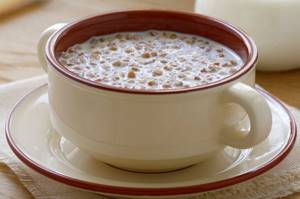
Traditionally, porridge is cooked in milk; this also applies to buckwheat; 100 grams of buckwheat with milk contains only 76 kcal. To improve the taste, buckwheat porridge with milk can be seasoned with butter, then the taste will become even more delicate. The calorie content of boiled buckwheat porridge with milk, butter and sugar increases by about 50 kcal/100 grams.
With stew
| Name | Quantity | fats | carbohydrates | squirrels | Total kcal |
| Buckwheat (2.5 cups) | 500 gr | 13 | 340 | 63 | 1729 |
| Stew (1 can) | 400 gr | 69.6 | 0 | 56.4 | 852 |
| Water (5 glasses) | 1.2 l | 0 | 0 | 0 | 0 |
| Onion (2 pcs) | 200 gr | 0 | 20.8 | 2.8 | 96 |
| Carrots (1 piece) | 100 gr | 0.1 | 6.9 | 1.3 | 35 |
| Volume. pasta (3 tablespoons) | 100 gr | 1.5 | 16.7 | 5.6 | 104 |
| Butter (3 tablespoons) | 100 gr | 82.5 | 0.8 | 0.5 | 744 |
| Total calories in 9 servings/250 grams | 2350 gr | 1500 | 1540 | 519 | 3560 |
100 grams of buckwheat with stew contains 151 kcal.
Stewed dishes are universal, easy to prepare and valued for their high taste.
With vegetables
| Name | Quantity | fats | carbohydrates | squirrels | Total kcal |
| Buckwheat (1 cup) | 220 gr | 5.72 | 150 | 27.7 | 760 |
| Water (2 glasses) | 480 ml | 0 | 0 | 0 | 0 |
| Carrots (1 piece) | 100 gr | 0.1 | 6.9 | 1.3 | 35 |
| Bow (1 piece) | 100 gr | 0 | 10.4 | 1.40 | 47.2 |
| Tomato (1 piece) | 100 gr | 0.2 | 4.2 | 0.6 | 21 |
| Sweet pepper (1 piece) | 100 gr | 0 | 5.3 | 1.3 | 26.4 |
| Sunflower oil (3 tablespoons) | 100 ml | 99.86 | 0 | 0 | 898.7 |
| Total calories in 4 servings of 260 grams | 1100 gr | 952 | 707 | 129 | 1789 |
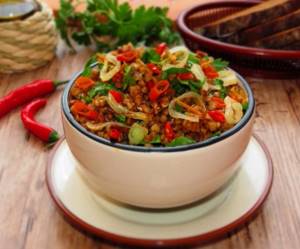
Juicy buckwheat with bright, healthy and low-calorie vegetables is a wonderful alternative to regular porridge, calorie content is only 162 kcal per 100 grams.
If you need to reduce calories, try using less oil.
How many calories are in buckwheat porridge per 100 grams?
Buckwheat was brought to us from Greece, which is why it got its name – buckwheat. Buckwheat is produced from the cereal crop - buckwheat, by cleaning the grain from the hard shell. Buckwheat stores well, does not go rancid, and is widely used for preparing various dishes.
After cleaning, the grain can be steamed, roasted or crushed. But vitamins are best preserved in unfried whole grains - buckwheat.
Dear readers, we invite you to SUBSCRIBE TO OUR NEW CHANNEL about weight loss and a healthy lifestyle. Useful materials will be published several times a week!
Despite its high calorie content, buckwheat is a dietary product due to its balanced combination of nutrients and fiber.
Table: calorie content of dry buckwheat, 100 grams of product contains:
| How much fat? | 2.6 g |
| How many carbohydrates? | 68 g |
| How many proteins? | 12.6 g |
| Total calories | 345 kcal |
Carbohydrates in cereals take longer to digest, which is why they are called “slow”; they create a feeling of fullness for a long time, which promotes weight loss. Many dishes are prepared from buckwheat: with milk, with mushrooms, with meat, with stew, with onions and vegetables - it goes well with a variety of products.
With milk
| Name | Quantity | fats | carbohydrates | squirrels | Total kcal |
| Buckwheat (half a glass) | 110 gr | 1.3 | 34 | 6.3 | 173 |
| Milk (1 glass) | 240 ml | 10.36 | 0 | 7. 68 | 124 |
| Water (1 glass) | 240 ml | 0 | 0 | 0 | 0 |
| Sugar (1 tablespoon) | 30 gr | 0 | 29. 9 | 0 | 119 |
| Total calories per 2 servings/270 grams | 550 | 105 | 255 | 56 | 416 |
Traditionally, porridge is cooked in milk; this also applies to buckwheat; 100 grams of buckwheat with milk contains only 76 kcal.
To improve the taste, buckwheat porridge with milk can be seasoned with butter, then the taste will become even more delicate. The calorie content of boiled buckwheat porridge with milk, butter and sugar increases by about 50 kcal/100 grams.
With stew
| Name | Quantity | fats | carbohydrates | squirrels | Total kcal |
| Buckwheat (2.5 cups) | 500 gr | 13 | 340 | 63 | 1729 |
| Stew (1 can) | 400 gr | 69.6 | 0 | 56. 4 | 852 |
| Water (5 glasses) | 1.2 l | 0 | 0 | 0 | 0 |
| Onion (2 pcs) | 200 gr | 0 | 20.8 | 2.8 | 96 |
| Carrots (1 piece) | 100 gr | 0.1 | 6.9 | 1.3 | 35 |
| Volume. pasta (3 tablespoons) | 100 gr | 1.5 | 16.7 | 5.6 | 104 |
| Butter (3 tablespoons) | 100 gr | 82.5 | 0.8 | 0. 5 | 744 |
| Total calories in 9 servings/250 grams | 2350 gr | 1500 | 1540 | 519 | 3560 |
100 grams of buckwheat with stew contains 151 kcal.
Stewed dishes are universal, easy to prepare and valued for their high taste.
With vegetables
| Name | Quantity | fats | carbohydrates | squirrels | Total kcal |
| Buckwheat (1 cup) | 220 gr | 5.72 | 150 | 27.7 | 760 |
| Water (2 glasses) | 480 ml | 0 | 0 | 0 | 0 |
| Carrots (1 piece) | 100 gr | 0. 1 | 6.9 | 1.3 | 35 |
| Bow (1 piece) | 100 gr | 0 | 10.4 | 1.40 | 47.2 |
| Tomato (1 piece) | 100 gr | 0.2 | 4.2 | 0.6 | 21 |
| Sweet pepper (1 piece) | 100 gr | 0 | 5.3 | 1.3 | 26.4 |
| Sunflower oil (3 tablespoons ) | 100 ml | 99.86 | 0 | 0 | 898.7 |
| Total calories in 4 servings of 260 grams | 1100 gr | 952 | 707 | 129 | 1789 |
Juicy buckwheat with bright, healthy and low-calorie vegetables is a wonderful alternative to regular porridge, calorie content is only 162 kcal per 100 grams.
If you need to reduce calories, try using less oil.
- We recommend reading: cleansing the body with buckwheat and kefir
With meat
| Name | Quantity | fats | carbohydrates | squirrels | Total kcal |
| Buckwheat (2.5 cups) | 500 gr | 13 | 340 | 63 | 1729 |
| Fillet of beef | 500 gr | 62 | 0 | 94. 5 | 936 |
| Bow (1 piece) | 100 gr | 0 | 10.4 | 1.40 | 47.2 |
| Carrots (1 piece) | 100 gr | 0.1 | 6.9 | 1.3 | 35 |
| Tomato. pasta (3 tbsp.) | 100 gr | 1.5 | 16.7 | 5.6 | 104 |
| Water (6 glasses) | 1. 4 l | 0 | 0 | 0 | 0 |
| Vegetable oil (2 tablespoons) | 60 ml | 59. 91 | 0 | 0 | 539 |
| Total calories per 10 servings/250 grams | 2500 gr | 1228 | 1496 | 663 | 3390 |
Buckwheat with meat turns out especially tasty if you bake it in pots; the energy value is only 135 kcal per 100 grams.
With mushrooms
| Name | Quantity | fats | carbohydrates | squirrels | Total kcal |
| Buckwheat (glass) | 220 gr | 5.72 | 150 | 27.7 | 760 |
| Champignon mushrooms) | 300 gr | 3 | 0. 3 | 12.9 | 80 |
| Onion (2 pcs) | 200 gr | 0 | 20.8 | 2.8 | 96 |
| Vegetable oil (1 table spoon) | 30 gr | 29. 96 | 0 | 0 | 270 |
| Water (2 glasses) | 480 ml | 0 | 0 | 0 | 0 |
| Total calories per 5 servings/220 grams | 1100 gr | 348 | 684 | 174 | 1206 |
Buckwheat porridge with mushrooms contains - a traditional Russian dish can be prepared with any mushrooms: dried, frozen, fresh.
The energy value of buckwheat with champignons is about 109 kilocalories per 100 grams.
With onion
| Name | Quantity | fats | carbohydrates | squirrels | Total kcal |
| Buckwheat (glass) | 220 gr | 5.72 | 150 | 27.7 | 760 |
| Bow (1 piece) | 100 gr | 0 | 10. 4 | 1.40 | 48 |
| Oil drain. (1 tbsp) | 30 gr | 24.75 | 0.24 | 0. 15 | 225 |
| Water (2 glasses) | 480 ml | 0 | 0 | 0 | 0 |
| Total calories per 3 servings/240 grams | 730 | 274 | 642 | 117 | 1033 |
Tender, crumbly buckwheat with onions and dietary gravy will perfectly satisfy hunger and is suitable for those who want to lose weight, because the calorie content per 100 grams is only 141 kcal.
beneficial elements in buckwheat
Table: content of microelements and vitamins per 100 grams of dry buckwheat
| Name | Daily requirement % | |
| Co (cobalt) | 3.1 mcg | 0.31 |
| PP (niacin) | 4.19 mg | 17 |
| K (potassium) | 380 mg | 19 |
| Ca (calcium) | 20 mg | 2 |
| Mg (magnesium) | 200 mg | 57 |
| B9 (folic acid) | 32 mcg | 3.2 |
| B1 (thiamine) | 0.43 mg | 29 |
| B6 (pyridoxine) | 0.4 mg | 20 |
| Fe (iron) | 6.6 mg | 44 |
| Cu (copper) | 0.64 mg | 43 |
| B2 (riboflavin) | 0.2 mg | 12 |
Buckwheat also contains manganese, chromium, silicon and zinc.
THESE ARTICLES WILL HELP YOU LOSE WEIGHT
Your review of the article: ( 987 4.50 out of 5) Loading…
With meat
| Name | Quantity | fats | carbohydrates | squirrels | Total kcal |
| Buckwheat (2.5 cups) | 500 gr | 13 | 340 | 63 | 1729 |
| Fillet of beef | 500 gr | 62 | 0 | 94.5 | 936 |
| Bow (1 piece) | 100 gr | 0 | 10.4 | 1.40 | 47.2 |
| Carrots (1 piece) | 100 gr | 0.1 | 6.9 | 1.3 | 35 |
| Tomato. pasta (3 tbsp.) | 100 gr | 1.5 | 16.7 | 5.6 | 104 |
| Water (6 glasses) | 1.4 l | 0 | 0 | 0 | 0 |
| Vegetable oil (2 tablespoons) | 60 ml | 59.91 | 0 | 0 | 539 |
| Total calories per 10 servings/250 grams | 2500 gr | 1228 | 1496 | 663 | 3390 |
Buckwheat with meat turns out especially tasty if you bake it in pots; the energy value is only 135 kcal per 100 grams.
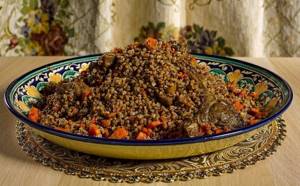
With mushrooms
| Name | Quantity | fats | carbohydrates | squirrels | Total kcal |
| Buckwheat (glass) | 220 gr | 5.72 | 150 | 27.7 | 760 |
| Champignon mushrooms) | 300 gr | 3 | 0.3 | 12.9 | 80 |
| Onion (2 pcs) | 200 gr | 0 | 20.8 | 2.8 | 96 |
| Vegetable oil (1 table spoon) | 30 gr | 29.96 | 0 | 0 | 270 |
| Water (2 glasses) | 480 ml | 0 | 0 | 0 | 0 |
| Total calories per 5 servings/220 grams | 1100 gr | 348 | 684 | 174 | 1206 |
Buckwheat porridge with mushrooms contains - a traditional Russian dish can be prepared with any mushrooms: dried, frozen, fresh.
The energy value of buckwheat with champignons is about 109 kilocalories per 100 grams.
With onion
| Name | Quantity | fats | carbohydrates | squirrels | Total kcal |
| Buckwheat (glass) | 220 gr | 5.72 | 150 | 27.7 | 760 |
| Bow (1 piece) | 100 gr | 0 | 10.4 | 1.40 | 48 |
| Oil drain. (1 tbsp) | 30 gr | 24.75 | 0.24 | 0.15 | 225 |
| Water (2 glasses) | 480 ml | 0 | 0 | 0 | 0 |
| Total calories per 3 servings/240 grams | 730 | 274 | 642 | 117 | 1033 |

Tender, crumbly buckwheat with onions and dietary gravy will perfectly satisfy hunger and is suitable for those who want to lose weight, because the calorie content per 100 grams is only 141 kcal.
With Chiken
| Name | Quantity | fats | carbohydrates | squirrels | Total kcal |
| Buckwheat (glass) | 220 gr | 5.72 | 150 | 27.7 | 760 |
| Chicken carcass (1 piece) | 1.2 kg | 154 | 0 | 176 | 2090 |
| Carrots (1 piece) | 100 gr | 0.1 | 6.9 | 1.3 | 35 |
| Bow (1 piece) | 100 gr | 0 | 10.4 | 1.40 | 47.2 |
| Sunflower oil (2 tablespoons) | 60 ml | 59.91 | 0 | 0 | 539 |
| Mayonnaise (1 tbsp.) | 30 gr | 20.1 | 0.78 | 0.93 | 188 |
| Water (2 cups) | 480 ml | 0 | 0 | 0 | 0 |
| Total calories per 7 servings/220 grams | 1600 gr | 2160 | 672 | 828 | 3660 |
Chicken stuffed with buckwheat is an appetizing, aromatic and very tasty dish that is perfect for a holiday table. The energy value of buckwheat with chicken is 228 kcal/100 grams.
The fairly high calorie content of the dish can be reduced if you do not coat the chicken with mayonnaise and stew the vegetables without vegetable oil; the calorie content will decrease by about 50 kcal/100 grams.
Content of useful elements in buckwheat
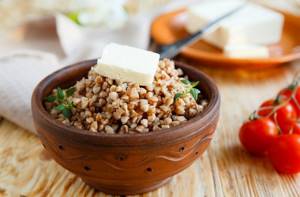
Table: content of microelements and vitamins per 100 grams of dry buckwheat
| Name | Content | Daily requirement % |
| Co (cobalt) | 3.1 mcg | 0.31 |
| PP (niacin) | 4.19 mg | 17 |
| K (potassium) | 380 mg | 19 |
| Ca (calcium) | 20 mg | 2 |
| Mg (magnesium) | 200 mg | 57 |
| B9 (folic acid) | 32 mcg | 3.2 |
| B1 (thiamine) | 0.43 mg | 29 |
| B6 (pyridoxine) | 0.4 mg | 20 |
| Fe (iron) | 6.6 mg | 44 |
| Cu (copper) | 0.64 mg | 43 |
| B2 (riboflavin) | 0.2 mg | 12 |
Buckwheat also contains manganese, chromium, silicon and zinc.
